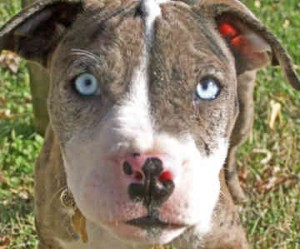Archive for October, 2011
How to adopt a rescue dog
 If you’re thinking of adopting a dog, consider a rescue dog. There are many dog rescue organizations across the country. Some focus on rescuing certain breeds such as Greyhounds that are usually put down after their racing career is over. Rescue organizations also focus on other breeds that have been abandoned. You would be doing a good thing by considering a rescue dog. The first thing that you need to do is go to a rescue website. If you are looking for a specific breed, there will be a link for rescued dogs. Petfinder is also a good choice for all breeds. Select the breed, size, age and enter your zip code. A list of dogs will come up in your surrounding area. You can also check out Petfinder if you are not looking for a specific breed. Pick out a dog and learn more about. You will be asked to fill out an application with details about you, your home, your family and your knowledge of dogs. You must also give the name of a veterinarian who could vouch for you. You will then be contacted and asked more questions. The rescue organization just wants to make sure that the dog is going to a good home and is not left alone the majority of the time.
If you’re thinking of adopting a dog, consider a rescue dog. There are many dog rescue organizations across the country. Some focus on rescuing certain breeds such as Greyhounds that are usually put down after their racing career is over. Rescue organizations also focus on other breeds that have been abandoned. You would be doing a good thing by considering a rescue dog. The first thing that you need to do is go to a rescue website. If you are looking for a specific breed, there will be a link for rescued dogs. Petfinder is also a good choice for all breeds. Select the breed, size, age and enter your zip code. A list of dogs will come up in your surrounding area. You can also check out Petfinder if you are not looking for a specific breed. Pick out a dog and learn more about. You will be asked to fill out an application with details about you, your home, your family and your knowledge of dogs. You must also give the name of a veterinarian who could vouch for you. You will then be contacted and asked more questions. The rescue organization just wants to make sure that the dog is going to a good home and is not left alone the majority of the time.
Be prepared for the foster parents to bring the dog to your home for a first visit. If the dog is at a kennel, you will be asked to go to the kennel. They will see how the dog interacts with you and how you interact with the dog.
If all goes well, your cost will be about $150 to cover shots, spaying/neutering and any other veterinarian costs. Some of the money will be allocated to rescue another dog. Most rescue organizations are non profit and the foster parents are all volunteers.
Give your new best friend lots of love, treats, exercise and pampering. Remember, your pets count!
Catahoula Leopard Dog – a very unusual breed
 The Catahoula Leopard is a versatile, working dog breed that originated in a region of Catahoula lake in central Louisiana. They have intriguing blue eyes and a strange coat. These dogs are extremely agile, territorial, athletic and very protective of “their property.” Psychologically, they are more primitive than other breeds and need constant reinforcement.
The Catahoula Leopard is a versatile, working dog breed that originated in a region of Catahoula lake in central Louisiana. They have intriguing blue eyes and a strange coat. These dogs are extremely agile, territorial, athletic and very protective of “their property.” Psychologically, they are more primitive than other breeds and need constant reinforcement.
Many people say that it’s hard to describe this dog unless you own one yourself. Some people call them “catdogs” because of their intuitive behavior and ability to climb trees. They are very intelligent dogs that needs lots of exercise and activity to keep them happy. They require a minimum of one hour of running each day and do not do well in urban areas for obvious reasons.
They make excellent working dogs and excel in herding, hunting and guarding. They are also used in police work for search and rescue and they also make excellent family pets.
The Catahoula is an assertive dog but not an aggressive one. If attacked, it will defend itself to whatever means necessary.
If you own one, spends lots of time with him in the park tossing him some of his favorite dog toys.
Halloween safety tips for your pets
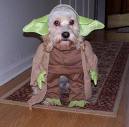 It’s that time of year again, tricks and treats and here are some ways to make sure that your pets stay safe.
It’s that time of year again, tricks and treats and here are some ways to make sure that your pets stay safe.
- Do not give any candy to your pets. This is for human trick or treaters only. Candy can make your pets sick and chocolate is highly toxic to a dog or cat.
- Keep wire and cords from electric lights away from your pets. If chewed, your pet could suffer cuts and burns and possibly a life threatening electrical shock.
- Don’t put a lit candle in your carved pumpkin if you have pets. They could easily knock it over and cause a fire. Kittens can get burned from the flame.
- Believe it or not, dogs hate being dressed up. Don’t put your dog in an uncomfortable costume unless you’re sure that he likes it. If you do dress up your dog or cat, make sure that he could move around in it and that it isn’t too tight.
- Keep the dog and cat away from the door when giving out those treats. The scary costumes could freak out your dog or cause your dog or cat to dart out the door into the dark.
- Make sure that your dog or cat has the proper ID in the event that he does escape.
- Popular Halloween plants such as pumpkins and decorative corn are considered to be relatively nontoxic, but they can produce stomach upset in pets who nibble on them.
Where your new kitten should sleep
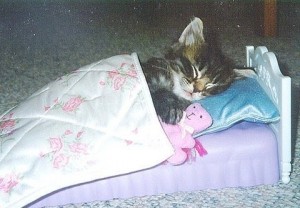 If you just got a new kitten, you probably know that cats are nocturnal animals. Their night time antics can keep you up at night. In the interest of your own sanity as well as your kittens health and safety, set the ground rules early on. If you allow your kitten to sleep in your bed overnight, you may be setting a precedent that you may later regret. Make his own cat bed instead. Place it somewhere quiet, warm and cozy. If kitty continues to climb out of his bed and into yours, you may want to keep him in a separate room at night. Remember, your pets count!
If you just got a new kitten, you probably know that cats are nocturnal animals. Their night time antics can keep you up at night. In the interest of your own sanity as well as your kittens health and safety, set the ground rules early on. If you allow your kitten to sleep in your bed overnight, you may be setting a precedent that you may later regret. Make his own cat bed instead. Place it somewhere quiet, warm and cozy. If kitty continues to climb out of his bed and into yours, you may want to keep him in a separate room at night. Remember, your pets count!
A cat that sneezes
 All cats sneeze every now and then and it’s usually no cause for alarm. Frequent sneezing, especially when one sneeze follows another can be allergies. Some culprits to consider are pollen, dust mites, cigarette smoke or household cleaners. Allergies can also cause a runny nose or eyes as well as a skin irritation. Always check with your vet to find out which pet medication would be best for helping kitty with her allergies.
All cats sneeze every now and then and it’s usually no cause for alarm. Frequent sneezing, especially when one sneeze follows another can be allergies. Some culprits to consider are pollen, dust mites, cigarette smoke or household cleaners. Allergies can also cause a runny nose or eyes as well as a skin irritation. Always check with your vet to find out which pet medication would be best for helping kitty with her allergies.
If your cat is over 3, sneezes and has stinky breath, this could mean tooth trouble. Aside from being painful, gum disease and abscesses could pose serious threat to your cats health. Habitual sneezing with mucus in the nose and eyes could mean that your cat has a bacterial respiratory infection. Bacterial infections require a trip to the vet for an antibiotic. A viral infection like feline herpes will eventually run its course even though your cat will remain a carrier for life. Don’t worry, this disease doesn’t spread to humans.
Cats are also highly susceptible to rabies and can pass the disease on to humans. This is a concern if your cat is outdoors. A more common disease is cat scratch fever caused by a cat scratch or bite. This is the most common disease that’s passed on the humans.
Don’t worry if you hear an occasional sneeze but make sure that if it’s something more to get your cat to a vet right away so both of you can live healthier lives. Remember, your pets count!
An easy way to get a cats urine odor out of your rug
 Cat urine can be difficult to remove from a carpet but it isn’t impossible. There are many products on the market and sold on e-bay but there a simple solution that you could try on your own. This method should get the urine and odor out without leaving a stain. Here are the ingredients that you’ll need.
Cat urine can be difficult to remove from a carpet but it isn’t impossible. There are many products on the market and sold on e-bay but there a simple solution that you could try on your own. This method should get the urine and odor out without leaving a stain. Here are the ingredients that you’ll need.
- 16 oz of Hydrogen Peroxide
- 1 teaspoon of dishwashing liquid
- 1 tablespoon of baking soda
Getting your dog to say “cheese”
 Taking a family photo with your pet is not an easy task. Your dog or cat will not sit and wait while you try to get the best lighting, angle or adjust your shutter speed. There are some tricks that you could use to capture them on film successfully. Don’t use your flash as this will startled them. Use natural light. Take your dog for a long walk or run before you begin. The exercise will reduce his energy level. If your looking to take the picture in a particular place or you wish to capture a certain scene, get everything ready ahead of time using stuffed animals as stand ins. Once you all set up, give your dog or cat some treats to get his attention. Be patient, give him lots of time to relax and then take lots of pictures for you to choose from.
Taking a family photo with your pet is not an easy task. Your dog or cat will not sit and wait while you try to get the best lighting, angle or adjust your shutter speed. There are some tricks that you could use to capture them on film successfully. Don’t use your flash as this will startled them. Use natural light. Take your dog for a long walk or run before you begin. The exercise will reduce his energy level. If your looking to take the picture in a particular place or you wish to capture a certain scene, get everything ready ahead of time using stuffed animals as stand ins. Once you all set up, give your dog or cat some treats to get his attention. Be patient, give him lots of time to relax and then take lots of pictures for you to choose from.
Remember, your pets count!
Keeping your cat out of the tub
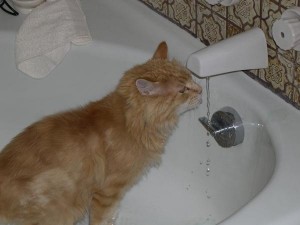 If your cat is like mine, he’s probably fascinated by the bath tub. They love dripping water. It’s entertaining to look at them looking at the drops and drinking as if there were drinking from a fountain. My both cats love this. My younger cat, Millie will actually wait at the bathtub or sink and “meow” to tell me to turn on the water for her, and yes, I do.
If your cat is like mine, he’s probably fascinated by the bath tub. They love dripping water. It’s entertaining to look at them looking at the drops and drinking as if there were drinking from a fountain. My both cats love this. My younger cat, Millie will actually wait at the bathtub or sink and “meow” to tell me to turn on the water for her, and yes, I do.
This all could become a problem if your cat thinks that the bathtub is the perfect litter box, you may need to keep him out o the bathroom. Fortunately, this is not the case with my cats. Always pay attention to where he is urinating and defecating as well as if there’s blood in his urine. If your cat’s litter box is clean and he still chooses to go in odd places, take him to the vet for an examination. You never know, it could be an underlying medical condition such as feline urinary tract infection, that is causing your cat’s unusual behavior.
Remember, your pets count!
Cat food labels
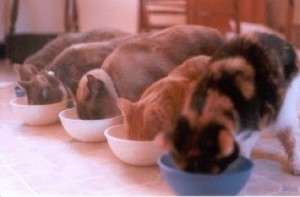 All pet food labels are regulated federally by the FDA. Many states also have their own requirements. In general, they must include nutritional value as well as feeding guidelines. When choosing a new cat food, compare labels. They could tell you a lot. You can start by reading the guarantee analysis section of a label. It will tell you more about the fiber, protein and water that is contained in the food. The next thing that you should do is look at the list of ingredients. They’re listed in order of weight. The first few things that you read will make up the bulk of the food. If you are unfamiliar will any ingredients or terms, ask your vet. Appropriate ingredients make for a healthy food for you cat. Take the time and learn more. Read the labels.
All pet food labels are regulated federally by the FDA. Many states also have their own requirements. In general, they must include nutritional value as well as feeding guidelines. When choosing a new cat food, compare labels. They could tell you a lot. You can start by reading the guarantee analysis section of a label. It will tell you more about the fiber, protein and water that is contained in the food. The next thing that you should do is look at the list of ingredients. They’re listed in order of weight. The first few things that you read will make up the bulk of the food. If you are unfamiliar will any ingredients or terms, ask your vet. Appropriate ingredients make for a healthy food for you cat. Take the time and learn more. Read the labels.
Remember, your pets count!
Feline Folklore
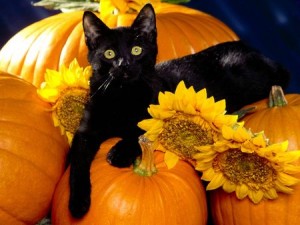 We see many images of black cats during Halloween. The idea that black cats are evil comes from the middle ages. This was the time that cats were associated with witchcraft. Superstitions about black cats are one of the most well known fables but they are not the only tales about cats. Many superstitions about cats are negative, like the idea that a sick person is destined to die if a cat jumps on his bed. There are a few positive ones. It’s been said that if a cat sneezes near a bride on her wedding day, she’ll have a happy life. In the theater, cats are considered good luck. Having one in the audience on opening night is thought to predict a successful play.
We see many images of black cats during Halloween. The idea that black cats are evil comes from the middle ages. This was the time that cats were associated with witchcraft. Superstitions about black cats are one of the most well known fables but they are not the only tales about cats. Many superstitions about cats are negative, like the idea that a sick person is destined to die if a cat jumps on his bed. There are a few positive ones. It’s been said that if a cat sneezes near a bride on her wedding day, she’ll have a happy life. In the theater, cats are considered good luck. Having one in the audience on opening night is thought to predict a successful play.
Remember, your pets count!
